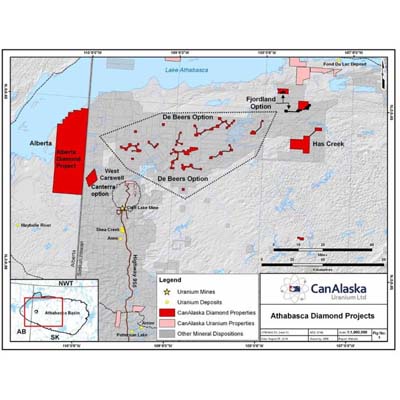De Beers returns West Athabasca to CanAlaska

Map of the Athabasca Diamond Projects. — Photo: CanAlaska Vancouver, Canada, December 23, 2016 - CanAlaska Uranium Ltd. (TSX-V: CVV; OTCQB: CVVUF; F
Map of the Athabasca Diamond Projects. — Photo: CanAlaska
Vancouver, Canada, December 23, 2016 - CanAlaska Uranium Ltd. (TSX-V: CVV; OTCQB: CVVUF; Frankfurt: DH7N), has received notice from De Beers for the termination of the West Athabasca project option. De Beers' exploration team has interpreted the 85 large magnetic anomalies scattered across the claims to be most likely associated with magnetic minerals within organic material in the overburden.
De Beers' drill program in September 2016 tested seven magnetic targets accessible before winter, located mostly in the southern claim groups. At five sites, the drill holes intercepted magnetic material within the organic overburden, unconsolidated sand and boulders, followed by sandstone. At one drill site, the overburden was not collected but the sandstone intercepted did not explain the associated magnetic anomaly. One drill hole intercepted overburden consisting of peat, unconsolidated sands and boulders, followed by sandstone and a thin diabase sill, which may explain the anomaly.
It is highly unusual to encounter such magnetic material in organic overburden. Samples from this material were sent to Saskatchewan Research Council (SRC) and McMaster University for analysis and review. There is some scientific literature that details bacterial production of magnetic material under certain conditions. Although the Western Athabasca Basin has the right geological and structural setting for the presence of diamondiferous kimberlite, De Beers decided not to continue drilling and, under the terms of the Option Agreement, have returned 100% of the project to CanAlaska.
CanAlaska President Peter Dasler commented, "I am very pleased with the excellent relationship we have developed with De Beers through this project. The Western Athabasca merits exploration for diamonds and we will now concentrate on evaluating several of the more interesting magnetic anomalies within the remaining 78 targets that CanAlaska does not believe are related to magnetic organic material. The series of positive and negative (reverse) magnetic responses that are evident from the recent airborne surveys on our nearby properties, specifically West Carswell and Alberta, would not be caused by similar organic material. CanAlaska is currently marketing its Alberta property to third parties to explore for diamonds, and with the return of 100% of the West Athabasca project, we expect that there will be parties that will wish to help us test the remaining targets."
In other news, CanAlaska has received correspondence from Cameco Corporation (TSX: CCO; NYSE: CCJ), in relation to the West McArthur uranium project; Cameco expects to be able to provide a 2017 exploration program and budget by January 31, 2017.
CanAlaska Uranium Ltd. (TSX-V: CVV; OTCQB: CVVUF; Frankfurt: DH7N) holds interests in approximately 500,000 hectares (1.2 million acres), one of the largest land positions in Canada's Athabasca Basin region - the "Saudi Arabia of Uranium." CanAlaska's strategic holdings have attracted major international mining companies Cameco, Denison, KORES, and KEPCO. CanAlaska is a project generator positioned for discovery success in the world's richest uranium district. For further information visit www.canalaska.com.




